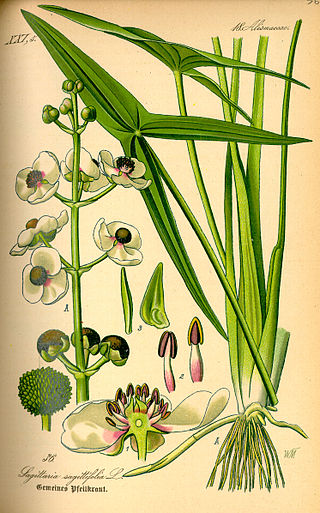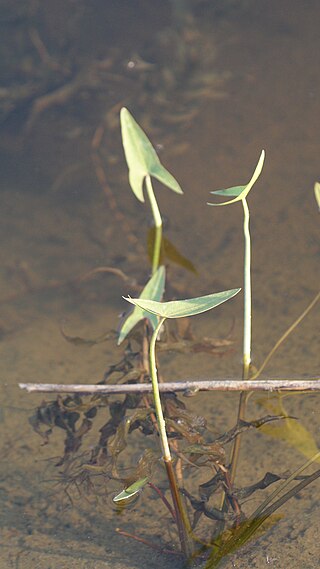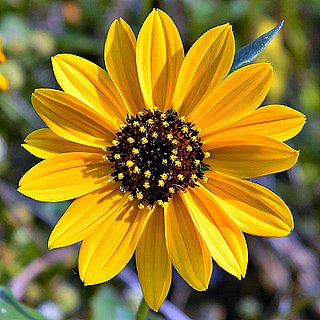
Pinus contorta, with the common names lodgepole pine and shore pine, and also known as twisted pine, and contorta pine, is a common tree in western North America. It is common near the ocean shore and in dry montane forests to the subalpine, but is rare in lowland rain forests. Like all pines, it is an evergreen conifer.

Sagittaria is a genus of about 30 species of aquatic plants whose members go by a variety of common names, including arrowhead, duck potato, swamp potato, tule potato, and wapato. Most are native to South, Central, and North America, but there are also some from Europe, Africa, and Asia.

Ruellia is a genus of flowering plants commonly known as ruellias or wild petunias. They are not closely related to petunias (Petunia) although both genera belong to the same euasterid clade. The genus was named in honor of Jean Ruelle (1474–1537), herbalist and physician to Francis I of France and translator of several works of Dioscorides.

Hesperaloe is a genus of flowering plants in the family Asparagaceae, subfamily Agavoideae. It contains perennial yucca-like plants with long, narrow leaves produced in a basal rosette and flowers borne on long panicles or racemes. The species are native to the arid parts of Texas in the United States and Mexico and are sometimes cultivated as xerophytic ornamental plants.

Legousia speculum-veneris, the looking glass or large Venus's-looking-glass, is an annual ornamental plant in the family Campanulaceae (bellflowers). It blooms from June to August and is native to the Mediterranean region.

Sagittaria secundifolia, also known as Kral's water plantain or Little River arrowhead is an endangered aquatic plant endemic to banks along the Little River of the U.S. states of Alabama and Georgia.
Micromonolepis pusilla, is the only species of the genus Micromonolepis in the flowering plant family Amaranthaceae, known by the common names small povertyweed and red povertyweed. It is native to the Western United States, including the Great Basin and surrounding areas, where it grows in sandy scrub, dry valleys, playas, and other open habitat. It is a somewhat fleshy annual herb producing a branching, slender stem that has a mealy whitish texture when young and turns dull to bright red with age, losing its grainy coat. It grows up to 14 to 20 centimeters tall. The thick oblong leaves are up to a centimeter long. Clusters of 1 to 3 minute flowers appear in the leaf axils, each flower made up of 3 tiny sepals.

Grindelia ciliata is a species of flowering plant in the family Asteraceae known by the common names Spanish gold, goldenweed, and waxed goldenweed.

Flacourtia indica, known commonly as ramontchi, governor's plum, Madagascar plum and Indian plum, is a species of flowering plant native to much of Africa and tropical and temperate parts of Asia. F. indica and F. ramontchi are sometimes treated as separate species.

Sagittaria cuneata is a species of flowering plant in the water plantain family known by the common name arumleaf arrowhead or duck potato. Like some other Sagittaria species, it may be called wapato. It is native to much of North America, including most of Canada as well as the western and northeastern United States.

Sagittaria longiloba is a species of flowering plant in the water plantain family known by the common name longbarb arrowhead and Gregg arrowhead. It is native to the south-central and southwestern United States plus Mexico, Venezuela and Nicaragua. It is also reportedly naturalized in the western Himalayas of India and Bhutan. It grows in slow-moving, stagnant, and ephemeral water bodies such as ponds and small streams, and sometimes disturbed and cultivated habitat such as rice fields and irrigation ditches.

Helianthus debilis is a species of sunflower known by the common names cucumberleaf sunflower, beach sunflower, weak sunflower, and East Coast dune sunflower. It is native to the United States, where it can be found along the Atlantic and Gulf Coasts. It is known elsewhere as an introduced species, such as South Africa, Australia, Taiwan, Slovakia, and Cuba.

Physaria parvula is a species of flowering plant in the family Brassicaceae known by the common name pygmy bladderpod. It is native to the Western United States, where it can be found in Colorado, Utah, and Wyoming.

Sagittaria isoetiformis, common name quillwort arrowhead, is an aquatic plant species native to Cuba and to the southeastern United States.

Sagittaria cristata, the crested arrowhead, is a plant species native to Ontario and north-central United States. It grows in shallow water along the edges of lakes, streams and marshes.

Sagittaria teres, the quill-leaved arrowhead or slender arrowhead, is an aquatic plant species in the genus Sagittaria native to the northeastern United States: Rhode Island, Massachusetts, New Hampshire, New York and New Jersey.

Sagittaria brevirostra, common name Midwestern arrowhead or shortbeak arrowhead, is an aquatic plant species native to North America. It is common in wet places in an area stretching from Michigan and Ohio south to Alabama and west to North Dakota, Colorado and northern New Mexico, plus isolated populations in Maryland, New Brunswick, Virginia, Saskatchewan and California.

Sagittaria filiformis, the threadleaf arrowhead, is an aquatic plant species native to the eastern United States, from Maine south to Florida and Alabama. it occurs in flowing streams in the northern part of its range, but more stagnant waters such as marshes and swamps in the South.

Sagittaria pygmaea, commonly known as the dwarf arrowhead or pygmy arrowhead, is an aquatic plant species. It is native to Japan, Korea, Taiwan, Thailand, Vietnam, Bhutan and China.

Clinopodium menthifolium, commonly known as the wood calamint or woodland calamint, is a species of flowering plant in the mint family, Lamiaceae. It is found throughout southern and central Europe from the United Kingdom and east as far as temperate parts of Asia, and as south as North Africa. It grows up to 1,700 m (5,600 ft) in elevation.























